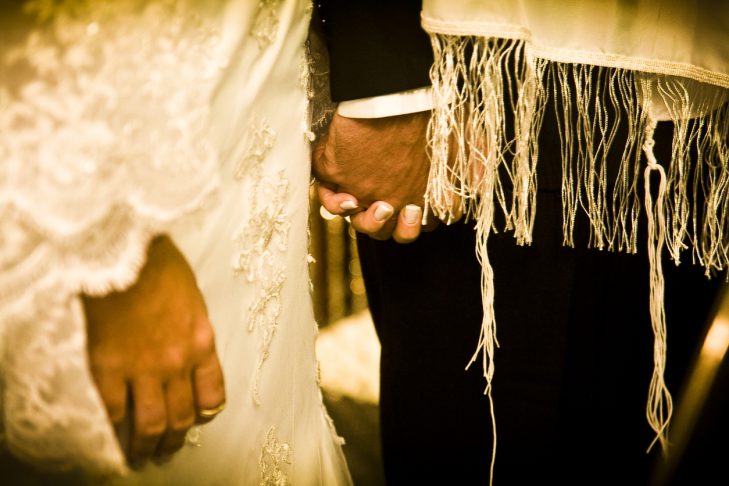So, has this happened to you before? You’re at a Jewish wedding, but have never been to Hebrew school. Moon languages have been spoken, glasses have been broken, and you’re just sitting down to your salad when the band strikes up in what sounds like Slavic.
You wonder what it is, but only for a moment, before getting yanked away from the walnut you had finally gotten onto your fork. Your wrist locked by the cold-iron grip of a cadaver who introduces herself as Aunt Freida, you’re led into an open-faced conga line—a geriatric game of “crack the whip” that is no one’s idea of a circle. You try to protest, but who can be heard over the ever-more feverish horns?
“Weren’t they just playing Bruno Mars?” you consider for the briefest of moments, before someone hands you a chair leg and you realize you’re holding aloft the bride.
You try to transfer some weight to your legs, but everyone else holding the chair is 5’4”. So you do the best you can to brace from the small of your back. But God help you, they’re lifting the chair up and down! The bride tilts precariously away from you and panic grips at the thought that her death will be on your hands.
You somehow manage, and bride and groom have been returned safely to earth. You cannot lift your arms. But the music continues, the circle reforms, and for 15 more minutes, at least it seems, the entire party shuffles shoulder-to-shoulder around the dance floor in no discernible pattern. At last, long past due, the horns grind to a halt, everyone collapses at their tables, and the meal is served.
Congratulations! You just survived the hora. A rite of passage for any Jewish wedding attendee.
A well-executed hora lies somewhere on the miracle spectrum between parting seas and working weekend subways. Having seen the carnage firsthand many times, allow me to offer the following as you try to navigate it without injury to pride or person. Just remember, nobody knows what they’re actually supposed to be doing. Including the bride and groom. So it’s fine.
Basics
“Hava Nagila” is the title of a song. It translates literally to, “We don’t know what we are singing.” (Not really.)
The hora is a dance you do to “Hava Nagila.”
So “The Hava Nagila” does not exist, in the same way that “The Party in the U.S.A.” or “The Be My Lover” by La Bouche do not exist. But if you ask, “Will the band play ‘Hava Nagila’?” the answer is, “Are bagels from Kulikov bigger than those from Lemberg?” Or, “Yes.”
Steps
Hora-ing, believe it or not, actually has steps. Don’t worry, nothing with “Cupid Shuffle”-level intensity. Here’s what you do:
- Let’s assume Aunt Freida’s got you in the circle. Figure out which direction you’re moving in. Excellent, you’re doing great so far.
- Take a step with your opposite foot in front of your leading foot. So if you’re going right, left foot over right foot. If you’re going left, vice versa.
- Take a step with your leading foot, so your feet are again parallel.
- Take a step with your opposite foot BEHIND your leading foot. Aha? See?
- Take a step with your leading foot back to parallel.
And you’re off! Or just walk like a normal person in whatever direction seems right.
Circles
The objective is to join hands with everyone to form a circle. Now here’s the trick:
- Advanced hora-ing trick No. 1: There should be more than one circle. A dance floor is small, but the wedding party is big. You have to use the entire space. So start small, and work out. Three circles is usually a good number. Two is just OK. Four is a circus.
- Advanced hora-ing trick No. 2: The circles should move in opposite directions.
If you don’t have someone on both sides of you, meaning your circle is not joined, just keep going! Grab people from the audience and force them to dance. People love being forced to dance.
Note: There may be a smaller circle of family at the center of the hora. The idea is to make the family feel like they are surrounded by the tribe, of which you are now very nearly a member.
Chairs
Once it’s gone on for a few minutes, someone will bring some chairs in. Up go the bride and groom, and maybe their parents too. The bride and groom will hold a napkin. This symbolizes the blood they will spill if dropped that you will have to clean. And also their connection.
If you aren’t lifting, keep dancing! Otherwise, you are just standing around watching people get lifted in chairs. That doesn’t make any sense. If you are lifting:
- Advancing hora-ing trick No. 3: Do not lift with people of unequal height. I can’t stress this enough.
- Advancing hora-ing trick No. 4: Be honest with yourself. Tap out when you’re done. But not while you’re holding somebody, in which case, that napkin is yours, my friend.
That’s it! You are now hora-ing! The mysteries of the universe have been laid before you like brunch with Aunt Freida, who is very impressed.
Benjamin Lack grew up in Atlanta, but is now based in Boston, where he is the head of a digital marketing consultancy. He is a graduate of the University of Georgia. And to all the single ladies, he is single, ladies.
This post has been contributed by a third party. The opinions, facts and any media content are presented solely by the author, and JewishBoston assumes no responsibility for them. Want to add your voice to the conversation? Publish your own post here. MORE

